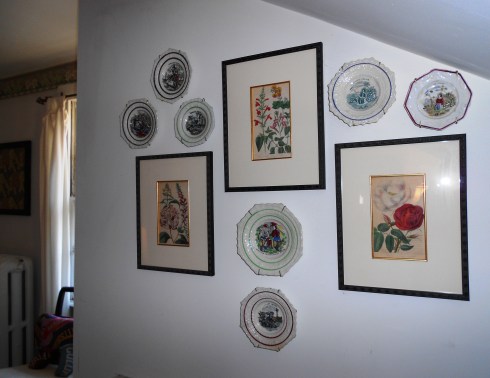I love little plates. I have stacks and stacks of old and new desert plates, salad plates, appetizer plates, saucers, and plates which seem to have absolutely no purpose beyond decoration. I hang them on the wall, I display them on mantels and bookcases, and then they go back into the stacks when I realize that there are just too many plates around. One of the few categories–or actually sub-categories–of plates that remain constantly on view are my Staffordshire “Robinson Crusoe” children’s plates, dating from the mid-nineteenth century. Somehow they just manage to keep looking good to me, or maybe it’s because I don’t go into the third-floor bedroom in which they are displayed very often.
Children’s plates were produced in large numbers in the nineteenth and early twentieth centuries and are consequently a relatively easy thing to collect (Best Books: Noel Riley’s 2-volume Gifts for Good Children. A History of Children’s China, 1790-1890). I have some which feature Benjamin Franklin maxims, domestic scenes, free trade slogans, animals, and the alphabet,but the Robinson Crusoe plates are my favorite even though they are in far from perfect condition: they are octagonal, transfer-printed (rather sloppily), and then “painted” with rather abstract strokes, as if the children themselves “colored” them, and most of them have a hairline fracture or two.
Daniel Defoe mined several true tales, most prominently that of Alexander Selkirk, a Scottish sailor who was marooned on a remote island off Chile (now called Robinson Crusoe Island) from 1704 to 1709 to come up with his elemental castaway story, Robinson Crusoe, in 1719, and the flood of texts, prints, plates and plays thereafter testify to its continuing popularity well into the twentieth century. According to the digital exhibition at the Lilly Library of Indiana University, the book has never been out of print. The title page from the Lilly collection is below, with my favorite edition, published in 1900 with illustrations by Louis and Frederick Rhead.
Editions of Robinson Crusoe published specifically for children seem to have the best illustrations. To make the story more accessible, sometimes Crusoe is transformed into a boy, and there was even a “little Miss Robinson Crusoe” in the 1920s. From the vast collection of historical children’s literature at the University of Florida, here’s a few of my favorite images: a rather ominous empty Robinson Crusoe suit from the title page of an 1845 English edition, the cover of an 1896 American edition illustrated by Walter Paget, and several pages from a Willy Pogany 1914 edition.
Robinson Crusoe shows up not only in books but also on all sorts of prints: he’s an early cartoon-strip character, an advertising device, and the subject of all sorts of dramatic presentations. He even shows up on wallpaper, back in the nineteenth century, and more recently on a Christopher Moore design for Lee Jofa.
1809 print by B. Tabart & Company and 1894 program for Robinson Crusoe play at the Drury Lane Theater, London, Victoria & Albert Museum; Advertisement for Fancy Dress Costumes, including the “Miss Robinson Crusoe”, New York Public Library Digital Gallery; Robinson Crusoe wallpapers from the Victoria & Albert Museum (circa 1875) and Christopher Moore/Lee Jofa.
And for the final touch (and also from the Victoria & Albert), a pair of “Robinson Crusoe” sunglasses manufactured by Oliver Goldsmith Eyewear in 1962, and apparently quite popular for a time. So there you are; certainly very few characters can make the leap from plates to sunglasses.





















January 18th, 2012 at 4:03 pm
Great post, love the plates, and all the illustrations. Inspired to do a post on my plate collection now!
January 18th, 2012 at 7:54 pm
my hip days are long behind me, but I still occasionally recognize it around the edges, and it strikes me that those sunglasses have revival possibilities
(and how fondly I remember reading an illustrated copy of Robinson Crusoe handed down from my grandfather)
January 19th, 2012 at 9:06 am
Hey, I like those sunglasses!
January 19th, 2012 at 5:41 pm
And you could wear them down there, Mark.